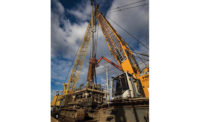Freshly armed in 1963 with a master’s degree in civil engineering from Istanbul Technical University, a young Ersin Arıoğlu and a partner had a daunting task: reinforce, upgrade and make an iconic contribution to Istanbul’s silhouette out of the Galata Tower, a building dating back to the Ottoman Empire.
“This project, with both of us being at the ages of 23 and̴24, laid a very heavy responsibility on our shoulders,” he says.
Related Article:
World's Longest Suspension Bridge Takes Shape in Turkey
Back to:
25 Top Newsmakers
Arıoğlu recalls he then had a dream in which he asked Mimar Sinan, the chief architect of the Ottoman Empire between 1539 and 1588, for advice. Sinan told him: “Don’t ask me, ask the building.”
So Arıoğlu did. “I discovered that I could almost feel the building’s centuries-old agonies and plight under the loads it was carrying as if through my own muscles, tendons and bones,” he recalls. “I would then ask myself which form would I take should loads be imposed on me, and how could I transfer loads to the ground? The sensation awakening in my muscles inspired the solution. It seemed as if I was developing empathy with the structure and the ground.”
That empathy has served him well ever since, including with clients and partners of the construction firm he founded with his colleague on the Galata Tower project. And Arıoğlu had another, more conscious dream when he visited his mother’s hometown in the Dardanelles Straits region. “When I passed the engineering school exams and became an engineering student, I started to think more deeply about what kind of bridge should be there. This dream continued in my mind for almost 30 years.”
Fulfilling a Dream
Together with his mentor Prof. Semih Tezcan, who served as president of Boğaziçi University, in 1992 Arıoğlu presented a proposal to Turkey’s General Directorate of Highways, and then at a suspension bridge conference in Oslo, Norway in 1994.
“The main span of that imaginary bridge was 1,510 meters,” says Arıoğlu. “Our courage was not enough to imagine a bridge with a span greater than that.”
The proposal evolved with the input of other suspension bridge experts, with the construction of two bridges over the Bosphorus Strait, and with the evolution of suspension bridge engineering that led to the world-breaking 1,992-meter-long span of the Akashi Kaikyo Bridge in Japan.
Now Arıoğlu’s dream is coming true, thanks to an international collaboration that includes COWI as the lead designer, and Turkey’s Limak and South Korea’s DL E&C and SK ecoplant as joint venture partners in the construction of the 1915 Çanakkale Bridge, which will set a new suspension main-span record of 2,023 meters.
“He always shared his approach with the project team, which was very helpful for us,” says Resit Yildiz, executive committee member with the joint venture. “He attended all the meetings with main designer candidates during our selection process—a solid indication of the emphasis he gives to design and engineering. His wisdom and extensive experience guided us through the project. We are happy to make his Çanakkale Bridge dream come true.”





Post a comment to this article
Report Abusive Comment